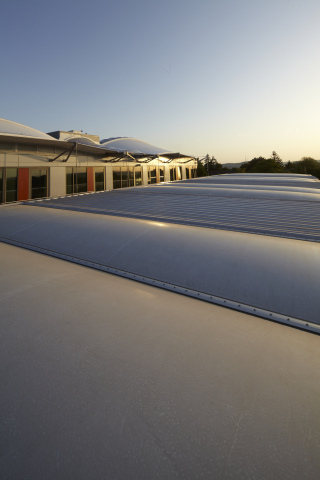Cabot Aerogel Enhances Daylighting Experience for German Energy Efficiency Center
Cabot aerogel enabled products deliver natural light, dramatically improve thermal performance and lower energy costs for innovative research and demonstration building

Energy Efficiency Center (EEC) at
The objective of the EEC project was to use energy-efficient technology in the building construction, in conjunction with an intelligent building design that focused on energy yield. The building is optimized to deliver superior energy conservation, sustainability and comfort. The EEC building serves as the ZAE Bayern research and testing facility as well as a modern energy information center that is open to the public and showcases exhibits, hands on energy experiments and more.
The two-story building is covered by a translucent roof membrane that serves as weather protection as well as an outer layer of the multi-layer structured roof. In part of the inner insulating layer, the EEC utilizes SCOBATHERM panels consisting of glass-fiber reinforced polyester that are filled with Cabot Lumira aerogel in the ceiling of the rooms. The translucent ceiling design enables optimal daylight conditions for the offices, and Cabot’s aerogel delivers the highest thermal performance and excellent light diffusion compared to typically used translucent systems. This combination enables the SCOBATHERM panels to redirect the light from the roof membrane deep into the offices while minimizing heat loss.
The EEC office area utilizes 24 panels of SCOBATHERM in the ceiling. The panels are filled with 50 mm Lumira aerogel and provide a U-value of 0.41 W/m²K, which is less than half the value possible with a triple glazed glass unit in this application. Unlike standard multi-layered glass panels, where the U-value increases significantly when used in horizontal applications, the SCOBATHERM panels with Cabot aerogel keep their ultra-low U-value even in horizontal applications.
The EEC also used OKAGEL light diffusing insulating glass units in the staircase area. Cabot’s Lumira aerogel particles provide translucency and serve as a highly effective thermal insulation. The staircase area utilizes 12 panels of OKAGEL insulating systems that contain 30 mm Lumira fill that deliver a U-value of 0.6 W/m²K. Using this unique aerogel system as a horizontal glazing in the ceiling, light can be diffused deep into the building. There is currently no other glass system that can bring diffused light into a building while achieving such an ultra-low U-value.
“The functional requirements of modern buildings have become more demanding, and today’s fenestration systems need to cover a variety of tasks,” said Raj Chary, vice president and general manager, Cabot Aerogel. “We are proud to be a part of this EEC project to showcase some of the ways that our aerogel technology can be applied by designers and architects in order to address some of today’s functional challenges. Cabot’s aerogel offers a number of new technical possibilities such as sustainable daylighting, light diffusion, UV stability, thermal insulation, and more.”
The project was funded by the
What is Cabot aerogel?
Sometimes called “frozen smoke,” aerogel is the lightest and best
insulating solid in the world. Cabot's aerogel is a hydrophobic aerogel
produced as particles. Each particle consists of more than 90 percent
air, contained in a structure that prevents heat transfer, for unmatched
insulation performance. Cabot produces its aerogel products, including
the Lumira® aerogel and Enova® aerogel brands in a
state-of-the-art manufacturing facility located near
ABOUT
Safe Harbor Statement under the Private Securities Litigation Reform Act of 1995: Statements in the press release regarding Cabot’s business that are not historical facts are forward looking statements that involve risks and uncertainties. For a discussion of such risks and uncertainties, which could cause actual results to differ from those contained in the forward looking statements, see “Risk Factors” in the Company’s Annual Report on Form 10-K.
Photos/Multimedia Gallery Available: http://www.businesswire.com/multimedia/home/20130916005234/en/
Source:
Cabot Corporation
Vanessa Craigie, 617-342-6015
Corporate
Communications
or
Erica McLaughlin, 617-342-6090
Investor
Relations
